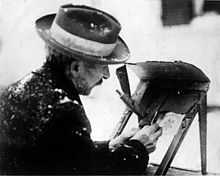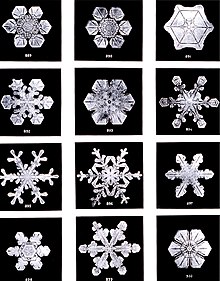Wilson Bentley
Wilson A. Bentley | |
|---|---|
 Bentley at work | |
| Born | Wilson Alwyn Bentley February 9, 1865 Jericho, Vermont, United States |
| Died | December 23, 1931 (aged 66) Jericho, Vermont, United States |
| Nationality | American |
| Known for | Pioneering the study of atmospheric ice crystal formation and snowflake photography |
Wilson Alwyn Bentley (February 9, 1865 – December 23, 1931), also known as Snowflake Bentley, was an American meteorologist and photographer, who was the first known person to take detailed photographs of snowflakes and record their features.[1] He perfected a process of catching flakes on black velvet in such a way that their images could be captured before they either melted or sublimated, and elaborated the theory that no two snowflakes are alike.
Kenneth G. Libbrecht notes that the techniques used by Bentley to photograph snowflakes are essentially the same as those used today, and that while the quality of his photographs reflects the technical limitations of the equipment of the era, "he did it so well that hardly anybody bothered to photograph snowflakes for almost 100 years".[2] The broadest collection of Bentley's photographs is held by the Jericho Historical Society in his home town, Jericho, Vermont.
Bentley donated his collection of original glass-plate photomicrographs of snow crystals to the Buffalo Museum of Science. A portion of this collection has been digitized and organized into a digital library.
Biography


Bentley was born on February 9, 1865, in Jericho, Vermont. He first became interested in snow crystals as a teenager on his family farm. “Always, right from the beginning it was the snowflakes that fascinated me most,” he said. “The farm folks up in this country dread the winter, but I was supremely happy.”[3] He tried to draw what he saw through an old microscope given to him by his mother when he was fifteen.[4] The snowflakes were too complex to record before they melted, so he attached a bellows camera to a compound microscope and, after much experimentation, photographed his first snowflake on January 15, 1885.[5] He captured more than 5,000 images of crystals in his lifetime. Each crystal was caught on a blackboard and transferred rapidly to a microscope slide. Even at subzero temperatures, snowflakes are ephemeral because they sublimate.[6]
Bentley described snowflakes as "tiny miracles of beauty" and snow crystals as "ice flowers."[7] Despite these poetic descriptions, Bentley brought an empirical method to his work.[7] In collaboration with George Henry Perkins, professor of natural history at the University of Vermont, Bentley published an article in which he argued that no two snow crystals were alike. This concept caught the public imagination and he published other articles in magazines, including National Geographic, Nature, Popular Science, and Scientific American. His photographs have been requested by academic institutions worldwide.[6]
In 1931 Bentley worked with William J. Humphreys of the U.S. Weather Bureau to publish Snow Crystals, a monograph illustrated with 2,500 photographs. His other publications include the entry on "snow" in the fourteenth edition of Encyclopædia Britannica.[8] Bentley also photographed all forms of ice and natural water formations including clouds and fog. He was the first American to record raindrop sizes, and was one of the first cloud physicists.[citation needed]
He died of pneumonia, which he may have contracted while walking home in the snow,[9] at his farm on December 23, 1931.[6][10] His book Snow Crystals was published by McGraw-Hill shortly before his death, and is still in print today.[citation needed]
Legacy
Bentley was memorialized in the naming of a science center in his memory at Johnson State College (now Vermont State University) in Johnson, Vermont. His lifelong home is listed on the National Register of Historic Places.[citation needed]
The Caldecott Medal winner in 1999 for the best-illustrated children's book was Snowflake Bentley, which remembers Bentley's life.[11]
At the Fairbanks Museum and Planetarium, a noted meteorological observation center in St. Johnsbury, Vermont, there is an exhibit about atmospheric ice crystal formation featuring several of Bentley’s photos and a short biography. Bentley was a friend of naturalist, industrialist, and collector Franklin Fairbanks.[citation needed]
Photomicrographs using Bentley's technique of a 19th-century collection of 19 glass-plate negatives of snowflakes held by the Geology Department of the Field Museum in Chicago have been assembled into a field guide by the museum.[12]
See also
References
- ^ Shz.de
- ^ "Historic Bentley snowflake photos for sale in US", BBC News, January 22, 2010
- ^ "The 'Ice Flowers' of Snowflake Bentley". The Attic. Retrieved February 1, 2019.
- ^ Martin, Jacqueline Briggs; Illustrated by Mary Azarian. Snowflake Bentley (Boston: Houghton Mifflin Company. 1998) ISBN 0-395-86162-4.
- ^ Hannavy, John (2007). Encyclopedia of Nineteenth-Century Photography. Vol. 1. CRC Press. p. 149. ISBN 978-0-415-97235-2.
- ^ a b c Moreno, Fred. 'Wilson Bentley: The Man Who Studied Snowflakes', Update (New York: New York Academy of Sciences, June/July/August 2005) pp. 8–9.
- ^ a b "Each Snowflake a Snapshot of Beauty - Wilson Bentley's Eureka". ZAGENO. Retrieved January 23, 2018.
- ^ "Bentley Snow Crystal Collection of the Buffalo Museum of Science: Other Resources". Archived from the original on June 7, 2007. Retrieved June 19, 2007.
- ^ Roman, Joe (January 2, 2023). "DAY TRIPS; A Place Where All the Snowflakes Are Still Different". The New York Times. Retrieved January 26, 2023.
- ^ [JHS] Wilson Snowflake Bentley – Photographer of Snowflakes (Jericho Historical Society, 2004). Retrieved July 26, 2005.
- ^ "Randolph Caldecott Medal". Association for Library Service to Children (ALSC). March 24, 2021. Retrieved January 24, 2022.
- ^ Raposa, Sara. "Snowflakes from the Field Museum Photo Archives" (PDF). Field Museum of Natural History. Retrieved November 13, 2021.
Bibliography
- Thompson, Jean M., Illustrated by Bentley, Wilson A. Water Wonders Every Child Should Know (Garden City: Doubleday, Page & Co. 1913)
- Bentley, Wilson A. The Guide to Nature (1922)
- Bentley, Wilson A. 'The Magic Beauty of Snow and Dew', National Geographic (January 1923)
- Bentley, Wilson A.; Humphreys, William J. Snow Crystals (New York: McGraw-Hill, 1931)
- Bentley, Wilson A. "Snow", Encyclopædia Britannica: Vol. 20 (14th ed., 1936; pp. 854–856)
- Knight, N. (1988) "No two alike?" Bulletin of the American Meteorological Society 69(5):496
Other reading
- Blanchard, Duncan. The Snowflake Man, A Biography of Wilson A. Bentley, (Blacksburg, VA: McDonald and Woodward, 1998) ISBN 0-939923-71-8.
- Martin, Jacqueline Briggs. Snowflake Bentley, (New York: Houghton Mifflin Co., 1998) ISBN 0-395-86162-4 (a children's biography illustrated with woodcuts hand tinted with watercolors by Mary Azarian. Awarded the Caldecott Medal.)
- Stoddard, Gloria May. Snowflake Bentley: Man of Science, Man of God (Shelburne, VT: New England Press, 1985) ISBN 0-933050-31-3 (Originally published in 1979 by Concordia Publishing House, ISBN 0-570-03620-8).
External links
- Snowflake Bentley.com
- New York Heritage - Bentley Snow Crystal Collection
- Works by Wilson Bentley at LibriVox (public domain audiobooks)

- Worldcat entry for Wilson A. Bentley Photographs at the Vermont Historical Society
- Bliss, Segment on Bentley Snow Crystal Starts at 34:00
